Concurrent Strength and Endurance Training

You know exercise can change your body. Through exercise, one can change parameters such as body composition, endurance capacity, maximal strength, efficiency, etc. The basis behind these changes is that the stress of exercise causes adaptations to occur in the body. The rule of specificity tell us these adaptations are specific to the training stimulus (Hickson). For example, the most effective way to increase a muscle’s maximum strength would be to specifically train that muscle through short-duration, high intensity resistance training, not through prolonged, low resistance repetitive contractions. Conversely, endurance based athletes like marathon runners or long distance cyclists, should train specifically for their endurance events by training over prolonged amounts of time with a lower sustainable resistance or work rate. With this said, how should athletes in events that require a mixture of strength and endurance train? Employing a training regime combining strength and
